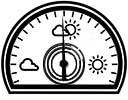Playing with HDR Photography
I’ve been meaning to experiment with HDR photography for a while but as with lots of my little projects just haven’t had the time to do so. I also didn’t have a tripod, but now I do, so the other evening I forced myself out to take some photos and give it a go.
I case you don’t know what it is, HDR stands for High Dynamic Range photography and means that you take several shots of the same scene at different exposure and merge them altogether on the computer afterwards. That may sound like cheating, but your eye is capable of seeing a dynamic range of something like 50,000:1 whereas film and digital camera can only ‘see’ (record) a dynamic range of around 300:1. This means that when you look at a scene such as the dunes and a sunset sky you can see detail in the shadows within the dunes and details in the brightest highlights. However, if you then take a photo of the scene, no matter where you meter something will be either under or over-exposed. If you meter for the sky the sunset will be well exposed but the dunes in the foreground would be cast into dark shadows. If you metered for the dunes then the sky would be overexposed. HDR allows you to combine these images and produce an image that is properly exposed throughout.
On a simple image such as the one described above it is actually quite easy to do this in camera with a graduated neutral density filter because the shadows are all at the bottom of the image and the highlights at the top so it is easy to place a filter over the image that essentially darkens the top of the image, but on more complex images where the shadows and highlights aren’t so simply aligned HDR is needed.
I only had a beach sunset scene to play with though so thought I’d give it a go so I popped across to the beach set my camera on its tripod and shot a quick image of the sunset with some of the dunes at the bottom of the view using the cameras Aperture Priority setting. I then took the same photo over-exposed by 1 stop (+1) and 2 stops (+2) and again underexposed by 1 stop (-1) and 2 stops (-2). In hindsight I should probably have made some shots with greater over and under-exposure probably up to +4 and -4.
As you can see, the results from these shots aren’t great, but they are the start of an HDR image.
The next stage was to merge the photos on the computer. (Although, I don’t think it will be long before some digitial cameras have built in HDR capabilities!). I decided to give the Merge HDR feature of Photoshop CS2 a go and compare it with the capabilities of Photomatix, a software package designed specifically for HDR photogaphy. The results from Photoshop were OK, and certainly better than any of the original images.
Photomatix on the other hand gives you many more options and features and makes a better job of aligning the images and tonal mapping. Of course, all of these options do mean that it takes a bit more time for you to get the setting just the way you want them.
The result are actually quite nice. I prefer the photomatix one as the details in the grass are much better. The subject and composition wasn’t great and the fact that there was a pretty strong wind blowing didn’t help. Keeping the camera dead still on the tripod in the wind isn’t possible and the wind meant that the clouds were moving quite fast so moved a little between exposures and of course the grass in the foreground was blowing about too. I shall play around with some better subjects soon.
Strangely these photos never look real even though it is probably closer to the way you actually see things. Maybe we’re just not used to seeing photographic images with such a high dynamic range.























Nice photos… Its good to see that you’ve seen the sun too, it seems to have gone missing here!